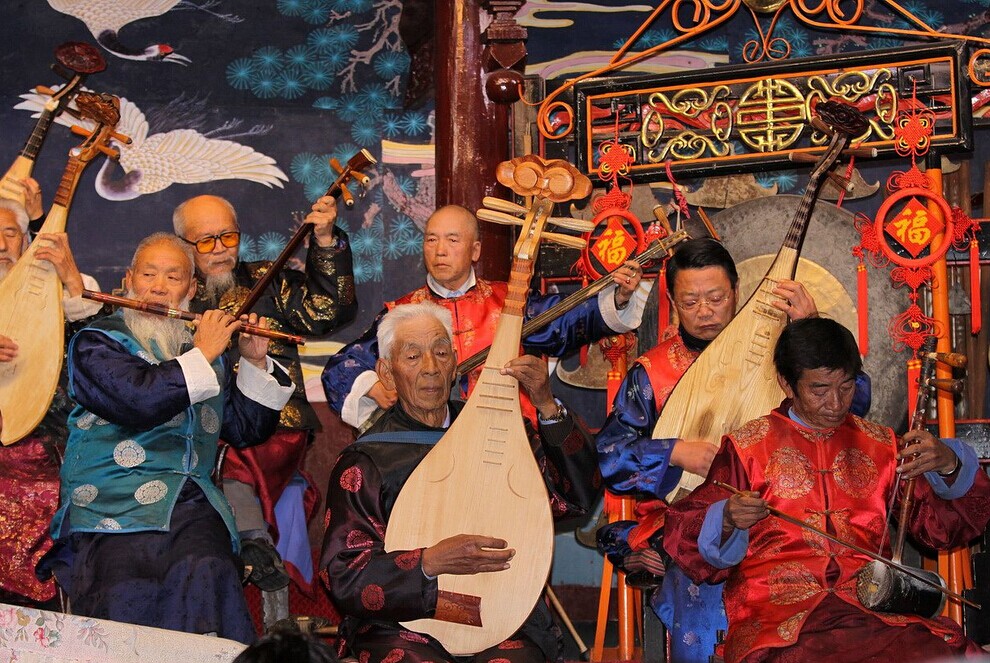23947. (Adam Grydehøj) Islands as Legible Geographies: Perceiving the Islandness of Kalaalit
. . . . . Nunaat [article]
23948. (David G. Harwell) Introduction to The Science Fiction Century [preface]
23949. (Frederik Pohl, C. M. Kornbluth & Dirk Wylie) Vacant World [story] [d]
23950. (N. K. Jemisin) Stone Hunger [story]
Read more »
READING — JULY 2018
Sichuan Folk Song
The huge western Chinese province of Sichuan has its own, distinct history. It consists of a broad and fertile basin around the city of Chengdu, ringed by a sparsely populated wilderness of mountains, forests and swamps. While this was a center of ancient non-Han civilization as early as the second millennium BC, it gradually became Sinified over the centuries, and the city and fertile regions are inhabited by Han Chinese speaking a southwestern dialect of Mandarin. However, most of the province consists of rugged mountains, and these are the home of many minority groups, ethnically and linguistically not at all Chinese. Among them are the Yi, related to the Burmese, the Qiang, and the Naxi (or Nakhi). The western half of the province is culturally closer to Tibet, many of the minorities speaking dialects of Tibetan, or closely related languages. All these minorities have distinctive musical traditions, and the metropolitan musical mainstream of China has drawn from them with the same mixing and mining process that went on in the development of America’s folk music. The album I have, Sichuan Folk Song and Ballad, Volume 2 gives a good sample of this variety. Personally, the more “folky” the songs are, the more they appeal to me. I particularly like the Naxi song “This Hill is Not As High As That One”.
China’s many ethnic minorities, who comprise tens of millions of people, have been hidden from the world’s view by millennia of obsessive imperial centralism and racism. In some cases, there are cultures of a million or more people about whom one cannot find a single book in a large university library. Can you imagine what it would mean if there was not a single book in a major library devoted to Wales, or the Basques, or to Estonia? Fortunately, the musical wealth of Sichuan can give us a foot-in-the-door to celebrating a diversity that has been kept from our view by ideology and intellectual laziness.
FILMS – JUNE 2018
(Almodóvar 1983) What Have I Done to Deserve This? [¿Qué he hecho yo para merecer esto!!]
(Fiveson 1979) The Clonus Horror [Mystery Science Theatre version]
(Oswald 1964) The Outer Limits: Ep.22 ― Specimen: Unknown
(Hitchcock 1940) Foreign Correspondent
(Dante 2013) Trailers from Hell: Joe Dante on Earth vs. the Flying Saucers
(Sears 1956) Earth vs. the Flying Saucers
(Wilder 1956) Witness for the Prosecution
Read more »
First-time listening for June 2018
25099. (Hector Berlioz) La Damnation de Faust [complete opera; d. Inbal; Gulyás, Lloyd, Ewing]
25100. (Dinah Washington) Dina Washington [Verve Jazz Masters #40]
25101. (Imagine Dragons) Night Visions Live
25102. (Lakshminarayana Shankar) Raga Aberi [w. Zakir Hussain]
25103. (Slam) BBC Essential Mix, May 1,1994
Read more »
READING — JUNE 2018
23925. (Antanas Sileika) Underground
23926. (Marc-Antonio Barblan) 1476 ― Le naufrage du grand Duché d’ Occident [article]
23927. (Hermione Hoby) A Story of Survival: New York’s Last Remaining Independent
. . . . . Bookshops [article]
23928. (Alex Preston) How Real Books Have Trumped EBooks [article]
23929. (Burjor Avari) India: The Ancient Past
Read more »
(Mankiewitz 1959) Suddenly, Last Summer
 It’s fascinating to see the twisting and turning in this film adaptation of Tennessee Williams’ play. In the 1950’s, American film was subject to government censorship under the notorious Hays Act, and to even more disgusting self-imposed censorship under the studios’ “voluntary code”. “It was like writing for Pravda,” said Gore Vidal, who scripted the film. In a wonderful documentary called The Celluloid Closet, he describes his repeated meetings with a Jesuit priest who, apparently, had life-and-death powers over any film production. Apparently, the very concept of homosexuality could not be allowed to appear on film. Since this was the central element of the plot, the result is a strange, almost hallucinatory atmosphere in which characters talk for ten minute stretches of oblique hints and enigmatic grimaces, merely to avoid mentioning that an absent character (who is dead) was gay! All this rigamarole is being done by Elizabeth Taylor during the period when she was a brilliant actress, Katherine Hepburn (who was always a brilliant actress), and Montgomery Clift. Clift was also a gifted actor, but at the time, he was recovering from a car accident that had disfigured his face, and was saturated with pain killers. He was also a closeted gay, himself. The scenes when all three of them are together are so filled with repression and tension that they count among the most bizarre and intense in film history. A viewer who is under twenty-five will probably find the whole thing incomprehensible. “What the hell are these people talking about, or more precisely, why are they not talking about it, what is everybody upset about it, and what on earth is going on?” was the response of one younger friend of mine. The whole thing was so alien to his experience and sensibilities that he could make no sense of it. And I couldn’t have explained it without undertaking a five hour discourse on the transformations in North American society in the lasty fifty years.
It’s fascinating to see the twisting and turning in this film adaptation of Tennessee Williams’ play. In the 1950’s, American film was subject to government censorship under the notorious Hays Act, and to even more disgusting self-imposed censorship under the studios’ “voluntary code”. “It was like writing for Pravda,” said Gore Vidal, who scripted the film. In a wonderful documentary called The Celluloid Closet, he describes his repeated meetings with a Jesuit priest who, apparently, had life-and-death powers over any film production. Apparently, the very concept of homosexuality could not be allowed to appear on film. Since this was the central element of the plot, the result is a strange, almost hallucinatory atmosphere in which characters talk for ten minute stretches of oblique hints and enigmatic grimaces, merely to avoid mentioning that an absent character (who is dead) was gay! All this rigamarole is being done by Elizabeth Taylor during the period when she was a brilliant actress, Katherine Hepburn (who was always a brilliant actress), and Montgomery Clift. Clift was also a gifted actor, but at the time, he was recovering from a car accident that had disfigured his face, and was saturated with pain killers. He was also a closeted gay, himself. The scenes when all three of them are together are so filled with repression and tension that they count among the most bizarre and intense in film history. A viewer who is under twenty-five will probably find the whole thing incomprehensible. “What the hell are these people talking about, or more precisely, why are they not talking about it, what is everybody upset about it, and what on earth is going on?” was the response of one younger friend of mine. The whole thing was so alien to his experience and sensibilities that he could make no sense of it. And I couldn’t have explained it without undertaking a five hour discourse on the transformations in North American society in the lasty fifty years.





